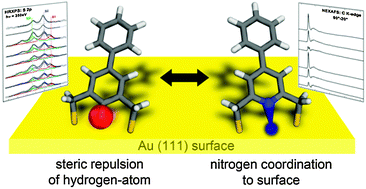Add a third hook: S-acetyl protected oligophenylene pyridine dithiols as advanced precursors for self-assembled monolayers†
Abstract
Self-assembled monolayers (SAMs) of

* Corresponding authors
a
University of Basel, Department of Chemistry, St. Johannsring 19, CH-4056 Basel, Switzerland
E-mail:
marcel.mayor@unibas.ch
Fax: +41 (0)61 267 10 16
Tel: +41 (0)61 267 10 06
b
Karlsruhe Institute of Technology, Eggenstein-Leopoldshafen, Germany
E-mail:
marcel.mayor@kit.edu
Tel: +49 (0)721 608 26392
c
Angewandte Physikalische Chemie, Universität Heidelberg, Im Neuenheimer Feld 253, 69120 Heidelberg, Germany
E-mail:
michael.zharnikov@urz.uni-heidelberg.de
Fax: +49 (0)6221 54 6199
Tel: +49 (0)6221 54 4921
Self-assembled monolayers (SAMs) of

 Please wait while we load your content...
Something went wrong. Try again?
Please wait while we load your content...
Something went wrong. Try again?
F. Sander, J. P. Hermes, M. Mayor, H. Hamoudi and M. Zharnikov, Phys. Chem. Chem. Phys., 2013, 15, 2836 DOI: 10.1039/C2CP43564K
To request permission to reproduce material from this article, please go to the Copyright Clearance Center request page.
If you are an author contributing to an RSC publication, you do not need to request permission provided correct acknowledgement is given.
If you are the author of this article, you do not need to request permission to reproduce figures and diagrams provided correct acknowledgement is given. If you want to reproduce the whole article in a third-party publication (excluding your thesis/dissertation for which permission is not required) please go to the Copyright Clearance Center request page.
Read more about how to correctly acknowledge RSC content.
 Fetching data from CrossRef.
Fetching data from CrossRef.
This may take some time to load.
Loading related content
